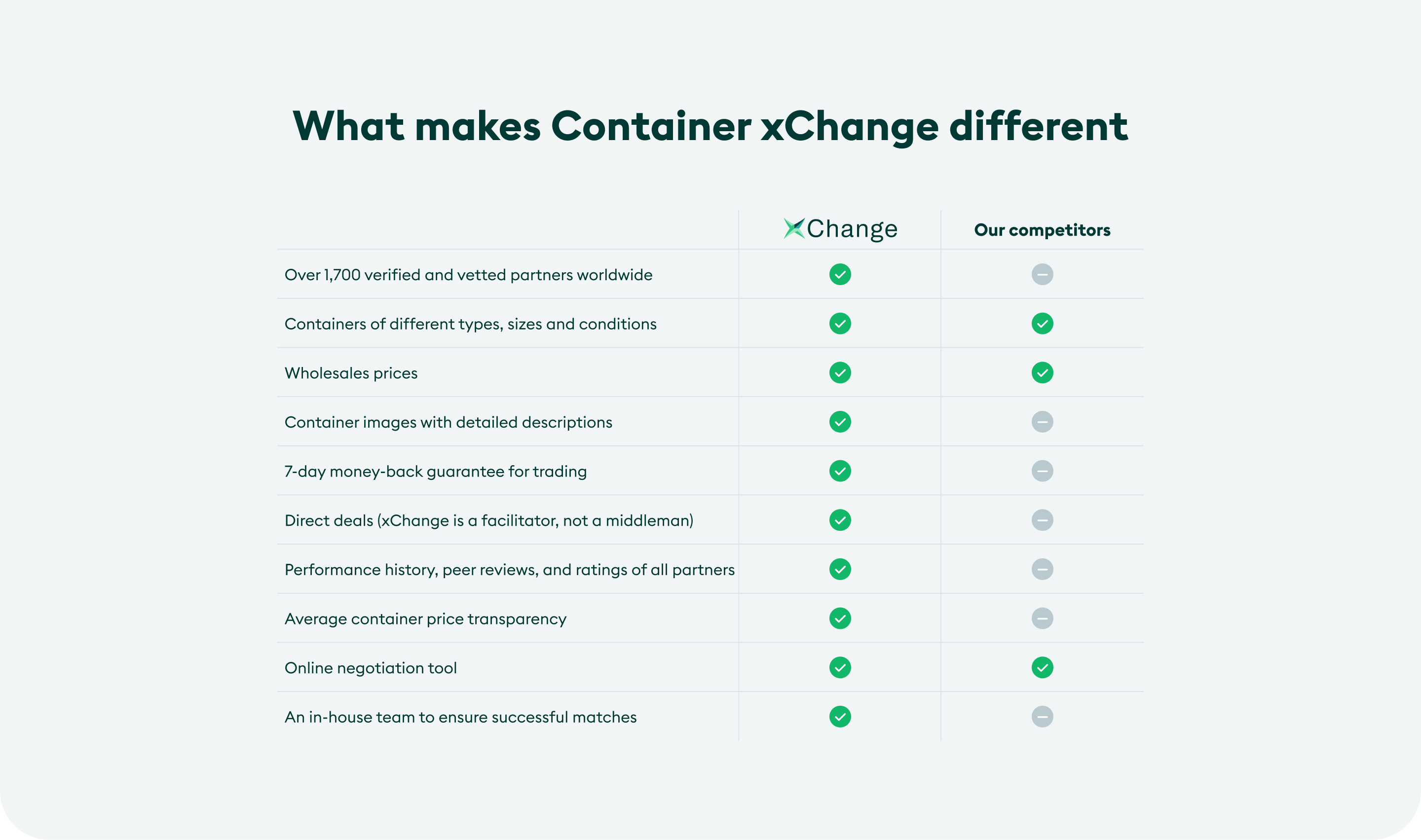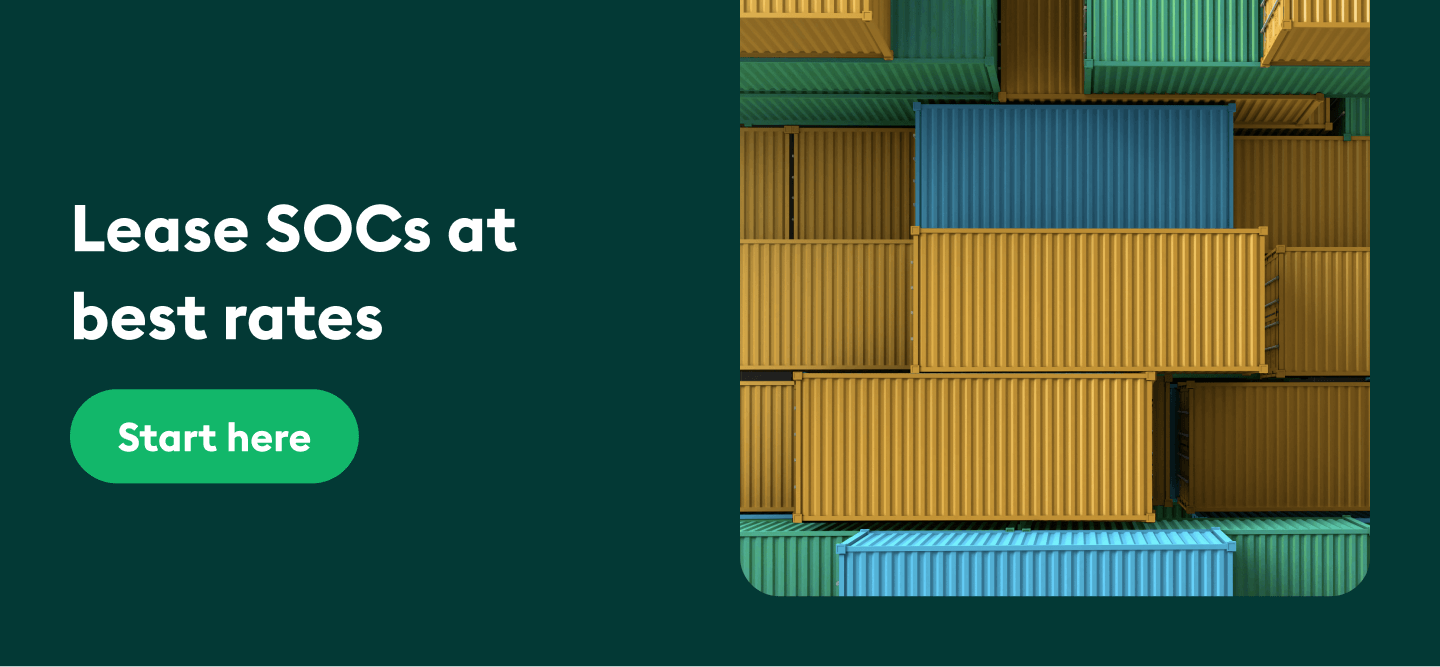Knowing the latest container leasing market trends will help you make smarter and more profitable business decisions. In this blog, get a complete industry overview and learn how to connect with vetted suppliers in just 3 easy steps.
The global container leasing market makes up a significant share of the logistics industry, and is growing at a rapid rate. Factors that make leasing increasingly attractive to shippers include flexibility, avoiding maintenance and storage costs, and saving on port charges.
In this blog, you’ll get a full market overview, insights into the latest leasing rates, as well as predictions for 2025.
However, if you’re here because you struggle to source containers to lease safely at budget-friendly prices, we’ll solve that issue for you too. On the Container xChange marketplace, you can access to 100,000+ container offers from 1,700+ vetted partners in one place.
Try out the public search below right now to find leasing deals in your location, hassle-free.
25 x 40HC
Container Supplier
Container Company Blurred Name
5
Pick-up charge
User pays
$120
19 Freedays
$44.20 Per diem
Container leasing market overview 2024
The container leasing market was valued at US $6.29 billion in 2023 and is anticipated to grow to US $8.8 billion by 2032. A CAGR of 4.3% is predicted during the forecast period (2024-2032).
This steady growth can be attributed to an ever-increasing demand for containers to import and export goods as international trade continues to expand.
Currently, about half of the global container fleet belongs to leasing companies, making them crucial players in the supply chain. These suppliers lease out units to shipping lines, freight forwarders, and shippers who prefer not to own their own containers due to the large capital investments required.
Having said that, the leasing market is dominated by just 13 companies, including Triton, Textainer, and CAI. This monopoly indicates a competitive landscape, which is challenging for smaller leasing companies to break into.
It also means limited negotiation power for shippers, as these players have significant leverage over pricing, as well as the terms and conditions of leasing agreements.
If you struggle to source containers at budget-friendly rates in such a competitive market, your search is finally over. On the xChange platform, you can negotiate the rates and contract terms directly with 1,700+ suppliers—no middlemen involved, no added commissions!
Click below to find out how you can get the best container leasing deals for your business—all without the stress of vetting suppliers or worrying about being overcharged.
Container leasing market: Regional insights
Now, let’s dive into the key leasing markets across different regions, and their projected growth.
North America: The North American market is expected to grow considerably during the forecast period, 2024-2028. This can be attributed to the adoption of advanced technology, coupled with the presence of large players in this region.
APAC: APAC (Asia-Pacific) accounted for approximately 47% of leasing market growth in 2023. Locations such as China, India, Australia, Malaysia, Japan, and Singapore are predicted to witness growth in port activities, a rise in the volume of containerized goods, and development in the manufacturing industry.
Europe: Europe plays an important role in the leasing market, with a CAGR of 4.1% predicted over the forecast period (2024-2031). This growth is driven by increasing awareness of sustainable practices, advancements in infrastructure, and a strong emphasis on improving efficiency within the supply chain.
India: India is expected to be one of the fastest-growing economies among the seven largest emerging markets and developing economies. The country is currently strengthening its trade ties, infrastructure, transportation, and logistics networks, in order to take advantage of rapidly evolving market conditions.
Want to keep up-to-date with global container leasing market news in key regions? Download ‘Where are all the containers’, our monthly logistics report, for free and get the latest industry insights now.
Container leasing market: Product segments
In the leasing market, there are several main product segments, each catering to different shipping needs and industries; dry containers, reefers and special units.
Dry containers: Standard containers are used to transport dry cargo of all kinds. These come in three sizes: 20ft, 40ft, and 40 foot high cube container.
Reefer containers: Reefers are designed with special cooling and temperature-regulation equipment. They’re essential for transporting frozen and temperature-sensitive goods.
Special containers: Special containers move extra-large and oddly-shaped cargo. These include open tops, tank containers, pallet-wide units, and flat racks.
It’s important to note that reefers and other special containers will be more expensive to lease than standard dry containers due to their specialized features or custom builds.
Container leasing industry: Cost overview
If you’re looking to lease containers one-way, it’s important to know what prices you can expect to shell out on major regional routes. Check out container leasing rates for standard containers on the xChange platform below:
To ship a 20ft dry container from Shanghai to Los Angeles, you’re looking at a pick-up charge of $570, a per diem charge of $4.05, and an average of 99 free days.
To lease a 40ft container from Shanghai to Chicago, you’ll shell out $900. The per diem for this stretch is $4.5, with an average of 75 free days.
Want to get containers at lower rates? Negotiate the price you want directly on the xChange leasing marketplace. Click below to browse and compare offers from 1,700+ trusted suppliers now.
Interested in leasing prices between China and Europe? Here’s a quick breakdown:
- 20ft container pick-up charges from Shanghai to Aarhus are $620
- 40ft container pick-up charges from Qingdao to Rotterdam are $283
- 40ft HC container pick-up charges from Shanghai to Aarhus are $1,468
With the volatile nature of the market, you must be able to negotiate a good deal with suppliers directly and cut out the middleman. The good news? You can do this with Container xChange and save big for your business! Discover the best deals today.
Lease containers at attractive rates
Top 10 container leasing companies in 2024
Curious about the top leasing companies in the world right now? Check out the top 10 below:
- Triton International: Based in Bermuda, Hamilton, Triton is the largest container leasing company in the world, with a fleet of 7 million TEUs.
- Textainer Group: Textainer supplies containers to over 200 customers, including all of the world’s major shipping lines. They currently hold 4 million TEUs.
- Florens: Headquartered in Hong Kong, Florens is one of the leading leasing companies with 3.89 million TEUs. Their customers include the top 20 shipping companies worldwide.
- SeaCo Global: This 50-year-old leasing company has 2.4 million TEUs and 370 depots worldwide.
- Beacon Intermodal: A significant player in the market, Beacon Intermodal has 1.8 million TEUs and operates in more than 125 ports around the globe.
- CAI International: Headquartered in Boston, CAI currently has more than 3 million TEUs and over 300 leasing customers.
- SeaCube Containers: SeaCube Containers has 2.4 million TEUs and operates in over 200 depots worldwide.
- Touax Container Solutions: Touax is the largest European leasing company, operating more than 400,000 TEUs in 13+ countries.
- Blue Sky Intermodal: Based in Marlow, UK, Blue Sky has a fleet of 300K TEUs. They specialize in leasing out standard shipping containers on long-term leases.
- CARU Containers: With headquarters in Rotterdam, CARU operates in over 70 countries, working with over 200 depots.
Want to connect with reputable names in the industry to get the best leasing deals within your budget? Book your free demo with our expert team today, and you’ll be connected some of the biggest industry names in no time at all.
Container leasing industry trends to look out for in 2025 and beyond
When it comes to the container leasing industry, it’s always important to keep your finger on the pulse. Here are some of the trends to watch out for over the next few years:
Increase in demand for reefer containers: With the increasing need for perishables, frozen produce, and medicines to be transported over long distances, we’re likely to see an expansion in the reefer market. This will mean ramping up the production of this specialized container.
Use of blockchain technology: Blockchain shipping technology is used to enhance security and transparency within the supply chain. We can expect to see blockchain technology being used to record the movement of containers and help to reduce fraud between parties.
Adoption of smart containers: Heard of smart containers? These are units equipped with IoT technology, allowing for real-time tracking and monitoring of units. Smart containers will eventually become essential within the supply chain.
Sustainable practices: As sustainability becomes more of a focal point in the shipping industry, we can expect to see more companies taking steps to reduce their carbon footprint. This includes adopting more energy-efficient technologies and finding ways to reduce empty container repositioning.
Types of container lease agreements
Before you lease a container, you’ll need to decide between four types of container leasing agreements. Here they are below:
Master lease: The duration of this type of lease may vary. Maintenance is done by the leasing company, and drop-off locations are restricted.
Long-term lease: This lease typically lasts 5-8 years. All repairs and maintenance are done by the lessee, and drop-off locations are restricted.
Short-term lease: Short-term leases are usually longer than 6 months. Maintenance is done by the lessee, and drop-off locations are heavily restricted.
One-way lease: With one-way leasing, the duration is agreed upon between the two parties, and the drop-off location is flexible.
For one-way leasing, you use SOCs (Shipper Owned Containers), as opposed to COCs (Carrier Owned Containers).
Here, you lease a unit from a container owner who needs to reposition their empty containers. You can agree on the leasing rate, per diem charges, and free days you’re comfortable with. In this way, you can avoid the port charges such as demurrage and detention that often come with using COCs—as these can start to add up!
If leasing SOCs sounds like the perfect solution for your business, keep reading. In the next section, we’ll tell you how to lease containers one way from trusted suppliers in just 3 easy steps.
Get budget-friendly leasing deals & save on costs with xChange
Transparent container prices, reliable partners, and commission-free deals could be your reality with the Container xChange marketplace. Here are the simple steps to finding the units you need on our platform:
Browse multiple leasing deals in one place: Once you know which container type and size you need, hop onto xChange’s leasing platform to browse available offers.
Here you’ll be able to see the pick-up charges, per diem charges, and free days. You can also check out the public profile of any company before deciding who to work with.
Negotiate rates directly with suppliers: When you see a good offer, reach out to the supplier directly to negotiate the rates and settle on the final details together.
Pay safely on the platform: Once the deal is finalized, make payments directly on xChange via our secure payment feature. All transactions are encrypted for an extra layer of security.
Once you subscribe to our online container marketplace, here are some of the benefits you’ll enjoy as a member:

Finally, gain access to 100,000+ containers of all types and sizes in one place, and find the best SOC leasing deals for your budget in no time at all. Click below to set up your free demo with our expert team today to learn how to get started right away.
Container leasing market: Common FAQs
What is container leasing?
Container leasing is when a shipper leases a container from a supplier rather than purchasing containers to move goods. The lessor leases containers from the supplier for a specified period and leasing rate, agreed upon by both parties.
What is the container leasing market size?
The shipping container leasing market was valued at $6,2 billion in 2023 and is predicted to reach $8,48 billion by 2032, with a CAGR of 4.3% during the forecast period 2024-2032.
Who is the largest container leasing company?
The largest container leasing companies worldwide include Triton, Textainer Group, Florens, and SeaCo Global. Currently, 13 leasing companies own the majority of the market share in the leasing industry.






